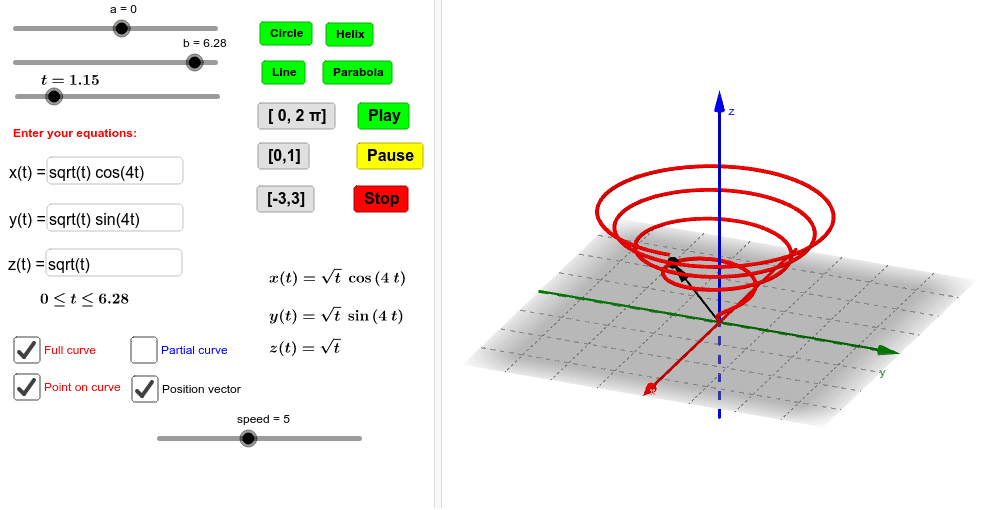

- #Geogebra 3d graphing calculator how to#
- #Geogebra 3d graphing calculator software#
- #Geogebra 3d graphing calculator free#
Augmented Reality View: Mobile Apps also offer the possibility to use Augmented Reality (AR).Tools View: Offers a range of essential tools for constructing points, planes, solids and vectors, as well as performing various actions like zooming, measuring, and transforming objects.Algebra View: Displays the algebraic representations of all created objects, like coordinates and equations, and enables you to enter algebraic expressions or commands.Graphics View: Showcases the visual representation of all created objects, such as points, solids, planes and many more 3D objects, providing an interactive 3D canvas for exploring mathematical relationships.

The 3D Calculator comprises the following components: Its dynamic features enable users to rotate, zoom, and explore 3D models, providing a deeper understanding of complex geometrical concepts. With this powerful app, you can create and manipulate 3D geometric objects, plot functions and surfaces, and investigate spatial relationships. They also helped me understand the intuition behind the formulas for finding the volume of such solids.The GeoGebra 3D Calculator is an innovative and interactive tool designed to help you visualize and explore three-dimensional mathematical concepts. $a$ and $b$ can be switched on or off and colors changed to give a better intuition of the solid.Īnd of course, the graph can be moved around and rotated to give a better sense of what the solid really looks like! I found these tools really helpful for visualizing solids of revolution, thus helping me solve problems involving these better. Most of the animated illustrations and all of the interactive simulations on this site were created using the wonderful GeoGebra software. For example, "The solid formed by rotating the area bound by the functions $x^2$ and $\sqrt$) must be replaced. Here's a quick overview of how solids of revolution can be graphed using either software: WolframAlphaĮxplain the figure in as precise a language as possible. You will write a two variable function for using x and y for and respectively. Additionally, spherical coordinates includes a distance called starting from origin. You can set the angles to create an interval which you would like to see the surface.
#Geogebra 3d graphing calculator free#
Free online 3D grapher from GeoGebra: graph 3D. GeoGebra and WolframAlpha (thanks seem to work well for me right now. This applet includes two angle options for both angle types. 3D graphing Desmos Help Center Desmos Help Center Graphing Calculator Calculator Features 3D graphing. I just found Math3D, so I haven't really had a chance to uncover its pros and cons. GeoGebra seems to have a very poor documentation, and Manim might be too complicated for simple graphs.
#Geogebra 3d graphing calculator software#
Perhaps a tip for that? Finding a good 3D graphing software would generally be useful though, since I'll probably need it anyways for future courses. Shows the region of integration for a triple integral (of an arbitrary function ) in rectangular coordinates.Note: To display a region that covers a large area over the -plane, it may help to turn density down first (and zoom out if necessary).
#Geogebra 3d graphing calculator how to#
I understand that parametric surfaces give a 3D vector in terms of $u$ and $v$, but I can't figure out how to convert solids of revolution to a parametric surface. I have to use parametric surfaces or something similar, which is difficult for me to do since I haven't really learnt about those. GeoGebra, Math3D, and Manim all seem to be good, but I don't really see an easy option to graph such solids of revolution. Is there any good software that I can use to visualize such solids formed from an arbitrary curve? Preferably even solids formed from an intersection of two such curves. Some solids of revolution are also formed by rotating the area under a 2D curve about the $y$-axis: In particular, we're learning about shapes called solids of revolution, which are formed by rotating the area under a 2D curve about the $x$-axis. I'm taking AP Calc with AoPS, and we're learning how to find the volumes of some 3D solids using integration methods.


 0 kommentar(er)
0 kommentar(er)
